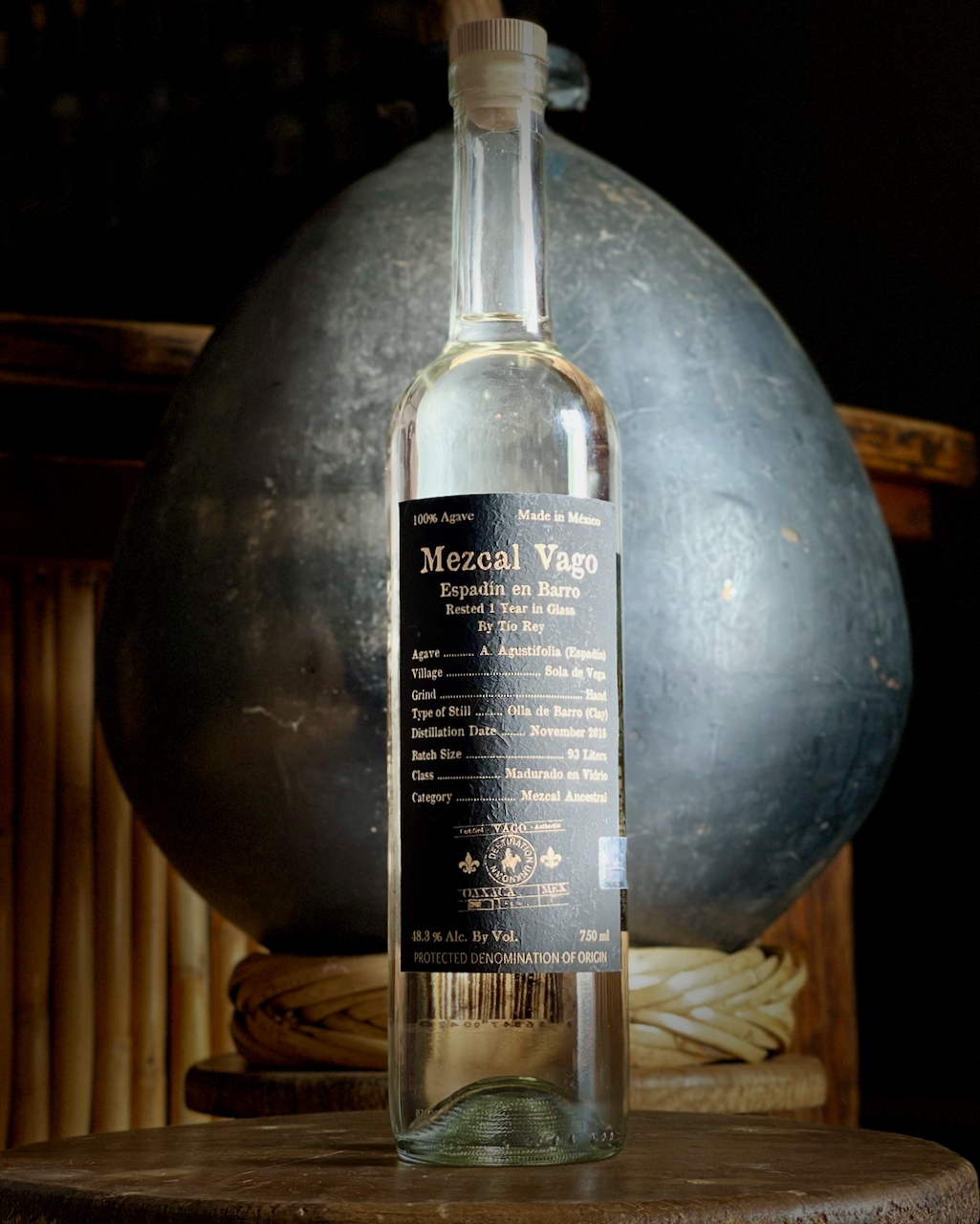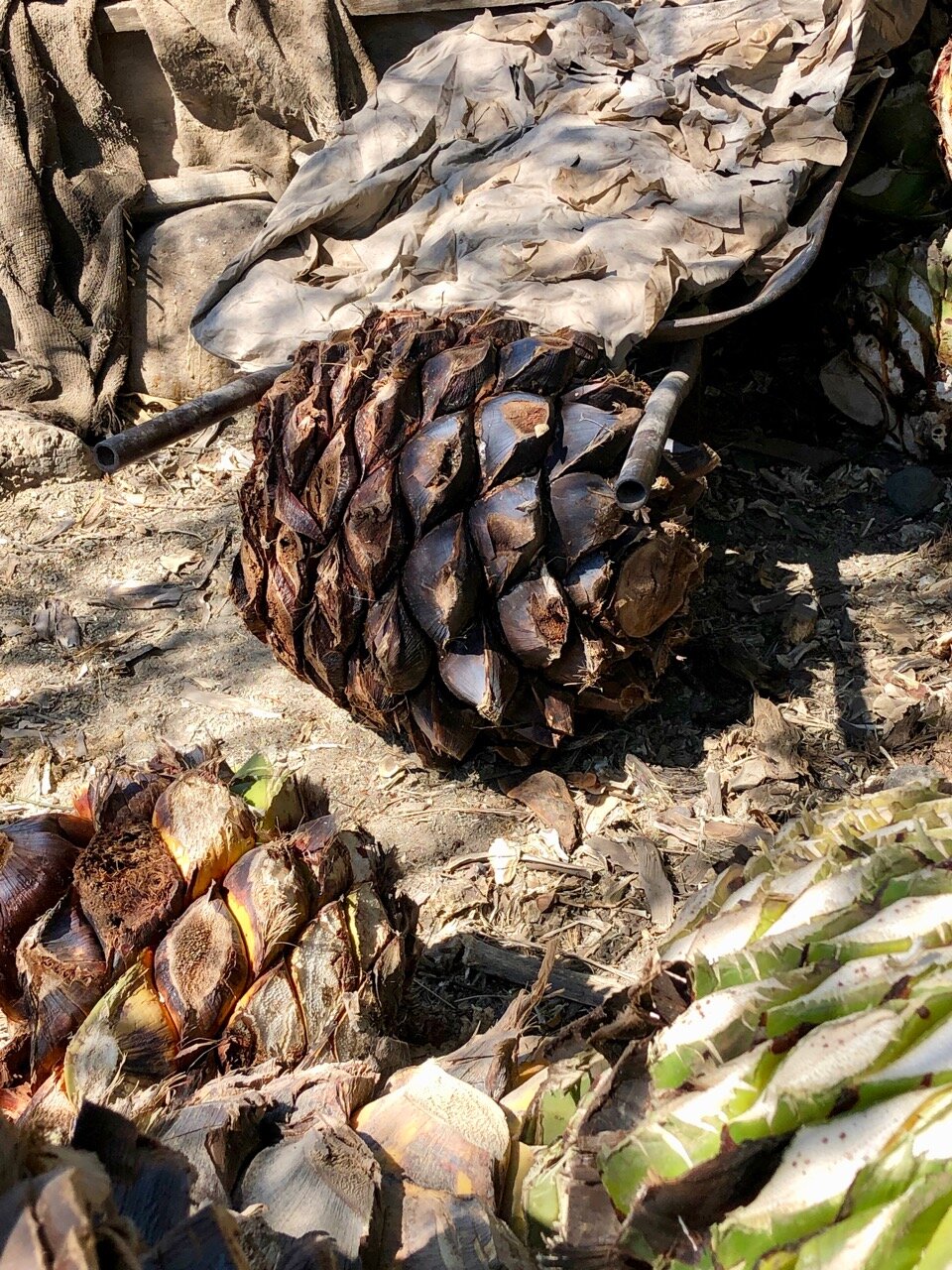Mezcal Vago Bien Picado
Mezcal Vago is excited to share our second ever release of a rare mezcal known as Bien Picado. This savory, earthy batch of Aquilino’s mezcal was produced from 89% Espadín and 11% Mexicano Verde. This small, 139-liter batch of mezcal was produced in February of 2019. Like our first limited run of this mezcal, produced in 2012, the entire batch was sent to our good friends in the great state of Texas. At 139-liters, if you haven’t already procured yourself a bottle, you should probably pony-up to your favorite mezcalería and ask them to pour you a taste. The long, rich finish will create a memory to last until our next batch.
This batch was harvested over February 19th and 20th, when 17 piñas of Espadín, weighing 1,635 kg were harvested along with only 4 piñas of Mexicano, weighing 183 kg. They were roasted underground in an earthen horno from February 20th through February 23rd. They were then allowed to rest for six days, between February 23rd and March 1st, when they were crushed on a stone tahona on March 1st and 2nd. The roasted agave produced 2,424 liters of juice and fiber which was placed in two wooden fermentation vats. Both vats were allowed to ferment for three days before adding 224 liters of fresh river water, resulting in 2,648 liters of fermented tepache, which fermented for eight days total. After the first distillation, the entire batch yielded 399 liters of ordinario at 27% ABV and 168 liters of mezcal at 63.7% ABV. The batch was allowed to rest for ten days before adding 50 liters of colas with water at 8% ABV, for a final bottling batch of 215 liters at 50.46% ABV. We decided to hold some back for the office and domestic sales, while the remaining 139 liters were all destined for the Lone Star State.
Bien Picado
The term Bien Picado is one you hear occasionally when visiting palenques in Oaxaca. When maguey is ripe it starts to sprout its quiote. When the quiote is up to a meter high they chop it off so that the sugars stay in the plant. Almost immediately after being cut the bugs called “picudos” which are the adult form of the gusano de maguey, begin to attack the plant. Picado can mean “bitten”, hence the term Bien Picado meaning “bitten up” as the gusanos and other bugs begin to eat it. If a plant is left too long it will eventually rot and die within a certain timeframe depending on the varietal. Espadín will last about three months before becoming over-ripe and starting to rot, but can sometimes last for over a year before becoming completely unusable. An average batch of Espadín (one oven full, or 1,000 kilos) is about 125 piñas, so the mezcalero waits until he has enough ripe piñas for a full batch. By the end, the oldest agave are starting to get over-ripe and others have just become ripe.
Bien Picado Espadín
Bien Picado Espadín (top right) and Mexicano
It’s normal for a batch of Aquilino’s mezcal Espadín to contain around 10% Espadín bien picado. Occasionally you will find a mezcalero who has a small batch made from more bien picado maguey that the mezcalero didn’t want to include in his normal batch. This is coveted and usually saved for themselves. There is less sugar but a more complex flavor profile.
Aquilino showing how the raw agave has started to break down
Aquilino’s first batch of Bien Picado was actually done by accident. He had more agave than he could process in a single batch, so he left those agave in the field until he could come back later to harvest them. One thing led to another, and he could not come back for several months. At that point, he noticed that the plants had started to discolor around the base and had basically begun to break down. As anyone who has visited a true mezcalero before knows, if there is one universal truth, it is that they do not waste a thing; so, Aquilino harvested these over-ripe agave and decided to process them as he would any other batch of mezcal. Aquilino ended up relishing the rich, savory complexity imparted by the lower sugar levels in the over-ripe maguey. It provided a full-body, without the typical fruity sweetness that accompanies Aquilino’s Espadín.
Aquilino García López
Aquilino is the father-in-law of Mezcal Vago’s co-founder, Judah Kuper. This family connection and his exquisite mezcal were the inspiration to form Mezcal Vago. Aquilino had never produced commercially before working with Mezcal Vago and produces exclusively for Mezcal Vago.
Aquilino García López, grows Maguey Espadín, and Maguey Mexicano. He wild harvests Maguey Cuixe (Tobaziche) and Tepeztate. He has taken over fields from his father and also has family and friends with whom he sources agave.
His palenque is in Candelaria Yegolé, Oaxaca (16°29'41.36"N, 96°18'38.69"W) This is a river town in a hot and dry climate at an elevation of around 1100 meters. Two rivers converge in a narrow Valley and it is mountainous on all sides. It is a rugged three-hour drive from Oaxaca city.
The palenque is on Aquilino’s ranch where he lives full time. He and his father moved it to its current location 15 years ago. It has moved around from nearby locations over the years. He believes his family has been making Mezcal for at least five generations. Aquilino does nearly all of the work himself.
The Agave Espadín and Agave Mexicano both take 7 to 9 years to mature and Aquilino is very careful about only using ripe agave. It takes 1000 kilos to yield around 100 liters of Mezcal. So every 10 kilos will yield a liter. The Espadín we cut ranges from 5 to 100 kilos per agave with an average of around 50 kilos for a well-grown ripe piña (agave heart). Therefore, one ripe Agave Espadín yields around seven 750ml bottles of Mezcal. A bit less but similar for Coyote, Arroqueño and Mexicano. Agave Tobalá and Cuixe yield even less.
Batch sizes of Espadín and Elote are around 750 liters. Each batch needs around 7 tons of cleaned and prepared agave piñas. Aquilino limits his batch sizes to one full oven.
The Mexicano and the Cuixe are smaller batches due to the availability of the agave. A batch of Mexicano is between 200 and 900 hundred Liters. The Cuixe is between 100 and 300 Liters (he only does around 2 a year.) The Cuixe is very laborious to make. Locating ripe agave growing wild and spread out over a large region surrounding the village takes lots of time and patience. Many of the agave are far from the road and need to be brought down the mountain by burro. The Cuixe is also laborious to clean and prepare and is tough to grind. It is roasted at least a full day longer than Espadín to fully extract the sugars.
Aquilino uses a traditional stone tahona to grind the cooked agave. All of the mashed agave and its juices are scooped together into the fermentation vats. A full oven of agave will take a couple of weeks to grind. This helps space out the fermentation process so not everything finishes at the same time.
Aquilino’s nine fermentation vats are made of pine and hold up to 1000 liters. The cooked agave and water ferment from the natural airborne yeasts in the air. No additional ingredients are used to make the mezcal other than agave and water.
Each batch ferments for around a week. This varies depending on the ambient temperature at the time of fermentation. Aquilino distills his fermented mash before all of the sugar has fermented. This is sooner than other mezcalero’s’ techniques.
Aquilino has a copper still that has a 250-liter capacity. He makes all the separations (cuts) by smell and taste. The heads are between 70% and 30% AVB and his tails are between 30% and 15% AVB. Everything else he doesn’t use.















